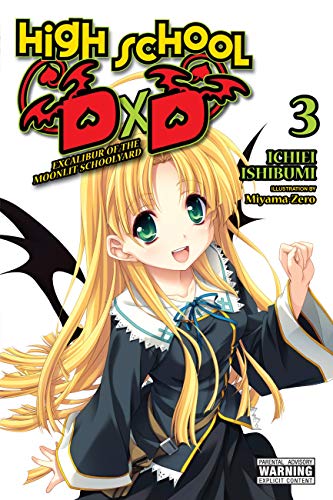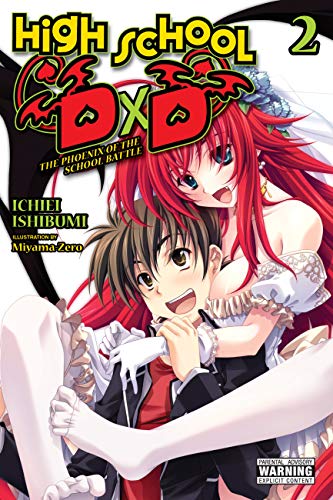By Ichiei Ishibumi and Miyama-Zero. Released in Japan by Fujimi Fantasia Bunko. Released in North America by Yen On. Translated by Haydn Trowell.
I had resolved, with this third volume of High School DxD, that I was going to stop talking about the constant teenage sex fantasy talk, nudity, and general fanservice and simply focus on plot and character. Theoretically, anyone reading a review of the third volume of this series already enjoys it, and does not need me going on about how it’s all a bit much. Therefore, I would simply glide past the fanservice and discuss other things. It’s very, very hard to do that, though. This is not a book like Accel World, where if you ignore the art and the ages of the characters it’s almost a normal harem battle novel. The sex is baked DEEPLY into the very fabric of the series. I could talk about character motivation, except we now see a THIRD demon whose plan is to gather a harem (and the second one had succeeded), and Issei explicitly says that he’s fighting in the final battle because he’s going to get to suck Rias’ nipples as a reward. It is what it is.
So, the plot, as there is one. Kiba finally gets a volume to explain his backstory, and it’s pretty wretched. It’s also pretty clear that he ids consumed by vengeance against holy swords. Thus it is an unfortunate thing that several holy swords have shown up in town, either being wielded by fallen priests, fallen angels, agents of the Church… or Issei’s childhood friend Irina, who he didn’t even realize was a girl. Needless to say, all these swords here is not a coincidence, and there’s a fallen angel at work here. Can our heroes manage to actually work together – minions of the angels and actual demons – to fight against a common enemy? Can Kiba manage to keep it together enough to get the revenge he’s sought for so long… and is revenge really the right answer? And can this series keep teasing sex while delivering precisely nothing? Signs point to yes.
I didn’t mention the other new character in this book, who seems to join the regular cast at the end. Xenovia starts off as an angel with a heaping of faith and a tendency to go off half-cocked, and ends it as a somewhat bitter demon… with the exact same tendency. She looks fun. Irina is far more pointless, and I think would have been better served being introduced in a different book. This book does, however, do something very well, which is for the climactic battle, which Kiba has far more invested in than Issei (nipples aside), it shifts to Kiba’s POV. You’d think this would be obvious, given it’s Kiba’s arc and resolution, but it can frequently be very hard to wrench the narrative away from the usual POV character, so I’m calling this a victory. Two more things: Koneko is still the minorest of the main characters, but I liked her more here. And a scene showing off how poor Irina and Xenovia really are shows the author is very good at humor when it’s not revolving around tits.
This series is pretty much review proof, but I will note: fans will enjoy it. Also, Asia looks very cute on the cover.


